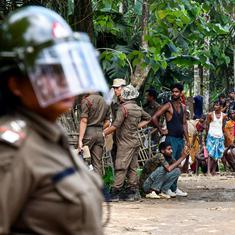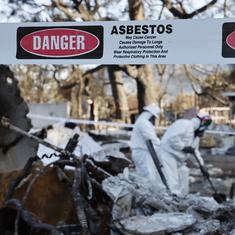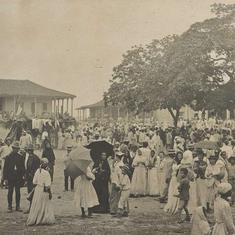Last week, Maneka Gandhi, the Bharatiya Janata Party’s candidate for Uttar Pradesh’s Sultanpur constituency, caused a stir when she told Muslim voters that if they did not vote for her, they could not expect her to help them if she won. The BJP minister emphasised that it would be evident if Muslims failed to vote for her, from voting patterns in neighbourhoods dominated by the minority community.
Said Gandhi: “When the election comes and this booth throws up 100 votes or 50 votes, and then you come to me for work we will see.”
On April 15, another video surfaced of Gandhi warning villagers in Pilibhit district that she would grade villages by the number of votes she receives and prioritise development work accordingly.
In theory, Indians are guaranteed a secret ballot by the Representation of People Act, 1951. Not so in practice, as Gandhi clearly pointed out, especially now that India uses Electronic Voting Machines.
Back when paper ballots were used, the Conduct of Election Rules of 1961 required votes from various booths to be mixed in drums before being counted. This ensured that ballots from a small polling area – street, colony, village – were anonymised. Since 2009, when EVMs started being used nationwide, Form 20 data, or polling booth voting data, is made publicly available by the Election Commission of India. The granularity of Form 20 data – which gives the number of votes received by all candidates, down to each EVM used – and its implications for privacy and the free exercise of a voter’s franchise, are troubling.
As one of the most populous countries with universal franchise, India breaks its own record for organising the “largest democratic exercise in history” every five years. In the 2019 election, to record the mandate of 90 crore voters, over 10 lakh polling booths will be set up. The election commission goes to extraordinary lengths to record every last vote. You may have read about polling officials travelling deep into Gujarat’s Gir forest to set up a booth for a single voter. Thanks to Form 20 data, we know that lone voter – Banej hamlet’s Bharatdas Darshandas, 55 – has consistently voted for the BJP in the last few parliamentary and Assembly elections.

This booth, along with a few others that record single-digit votes, may be outliers, but they show that the ballot is no longer really secret in sparsely populated or remote areas. Ordinarily, an EVM is allotted per 1,000-1,500 voters but records an average of 200-600 votes. This means even electors living in densely populated areas would be wrong to assume their votes are safe from being similarly scrutinised by political parties.
Risking life and liberty
Then there are electoral rolls, which reveal the name, address, age and gender of every voter and the booth where they are registered. Political parties invest huge resources in digitising this data to deduce the caste and religious makeup of every locality. The information informs their messaging and voter outreach programmes. The waters get muddied when parties read electoral rolls with EVM data to find out which neighbourhoods or communities voted for or against them. The BJP, armed with this data, mobilises its “panna pramukhs”, each of whom is handed a single page of electoral rolls and is expected to persuade 30 to 60 people to vote for the party.
Confidence in the accuracy of such extensive booth management is why politicians such as Gandhi threaten with impunity to find those who do not back them. It was reported after the Karnataka Assembly elections last year that supporters of the Janata Dal (Secular) went on a “celebratory rally”, quarrelling with people in areas that voted for the rival candidate. This is just one of many reported instances of retaliation by party workers in areas where they did not receive support. It puts at risk the life and liberty of especially those Indians who live in ghettoised or sharply segregated neighbourhoods.

The backlash may no longer be limited to violence and intimidation but, as Gandhi threatened, it can even affect people’s access to public services and welfare schemes. The use of the state machinery by the incumbent party to tilt the election in its favour is expressly prohibited by the Model Code of Conduct. Yet, data of the beneficiaries of welfare schemes – which is a public asset even though it is not explicitly seen thus, as of now – is being unfairly leveraged by the BJP. The party’s chief, Amit Shah, for one, has reportedly directed his workers to reach out to 22 crore beneficiaries of central welfare programmes in a bid to tackle anti-incumbency.
Civil society activists have been highlighting how the data of beneficiaries is being fraudulently mined from mobile apps and how attempts to merge the Aadhar-linked State Resident Data Hubs with the Electoral Photo ID Card database has the potential for misuse. Just last week, the Aadhaar authority filed a complaint against IT Grids, a company accused of illegally accessing sensitive information of nearly 7.8 crore people – Aadhaar numbers, voter identities, beneficiary details of the Andhra Pradesh government’s welfare schemes – through the Seva Mitra app of the ruling Telugu Desam Party.
Women and Child Minister #ManekaGandhi on camera says:
— Khabar Bar (@Khabar_Bar) April 12, 2019
“I am going to win for sure. If Muslims won’t vote for me and then come to ask for work, I will have to think, what’s the use of giving them jobs.”#LokSabhaElections2019 @ECISVEEP pic.twitter.com/BHG5kwjwmQ
Need for the totaliser
Aware of the dangers of Form 20 data, the election commission has, since 2008, been asking for totaliser machines to count votes. The totaliser adds together votes from 14 EVMs so that booth-level data is not recorded and aggregate data alone is made available. This is called cluster counting.
However, responding to a public interest litigation in 2017, the central government opposed the election commission’s suggestion for cluster counting and told the Supreme Court that using the totaliser “did not serve any larger public purpose”. The government took this position based on the deliberations of a committee of ministers including Rajnath Singh and Arun Jaitley.
In November 2018, a petition for an urgent hearing on the introduction of the totaliser to ensure secrecy of the ballot was turned down by a Supreme Court bench led by Chief Justice Ranjan Gogoi. The Indian judiciary is seen as a bulwark against encroachment on citizen’s political rights but it did not seem too enthused about this matter. There’s now no possibility of totaliser machines being deployed in this election.
It is a cruel joke that while voters no longer have the guarantee of secret ballot, Attorney General KK Venugopal last week defended the electoral bonds scheme on the grounds of corporate donors’ “right to secrecy”.
Compounding the problem is the election commission’s ill-considered sharing of sensitive information of voters. According to the proposed principles on privacy laid down by the Justice BN Srikrishna Committee, the commission would require the “specific and explicit consent” of voters before sharing their personal data such as addresses and voter card details. It is abundantly clear this data serves little public good and only benefits political parties, to the detriment of voters’ privacy. There is this no rationale for it being made freely available.
On April 14, Opposition parties said they would petition the Supreme Court to order mandatory verification of 50% of VVPAT slips, which are the paper receipts of votes cast electronically. Using VVPAT to ensure the integrity of elections occupies a significant part of the public debate on electoral reforms today. But if the Opposition is truly committed to protecting voters’ rights as they claim to, they would do well to persuade the Supreme Court to admit a plea on the use of totaliser machines. Or, at the least, demand a stay on the release of booth-level polling data by the election commission to safeguard voters’ privacy. For the free exercise of our franchise, the totaliser is arguably a more important machine than the VVPAT.
Ishita Trivedi is an independent policy consultant. She has worked extensively with electoral data and tracked regional disparities using nightlights satellite data.
Also read: Data-grabbing, the victim card, targeted ads, fake news: How to win an Indian election
Watch: BJP leader Sakshi Maharaj threatens to put a curse on people who don’t vote for him










